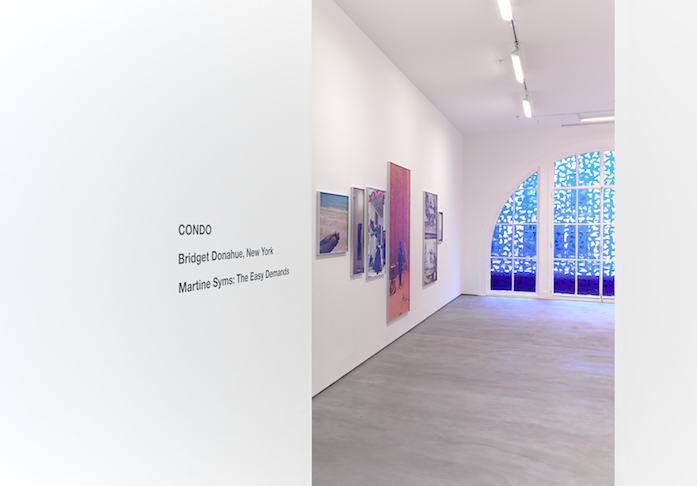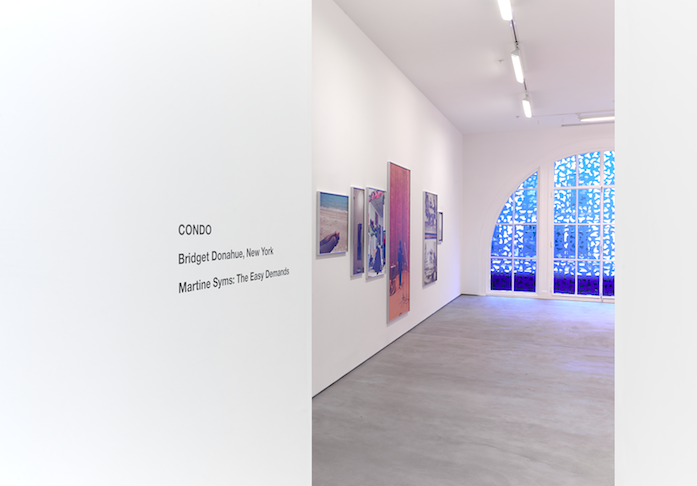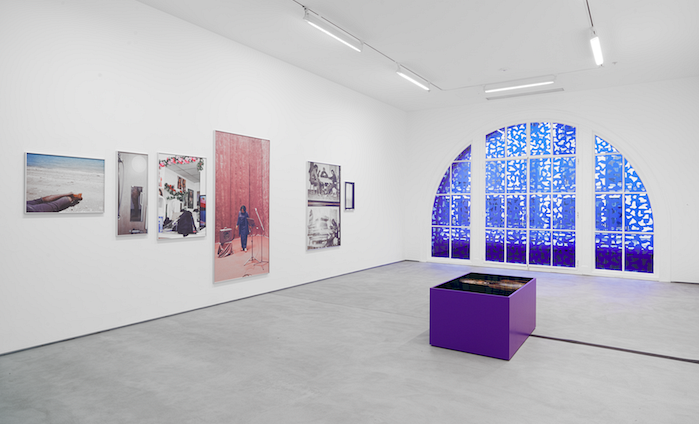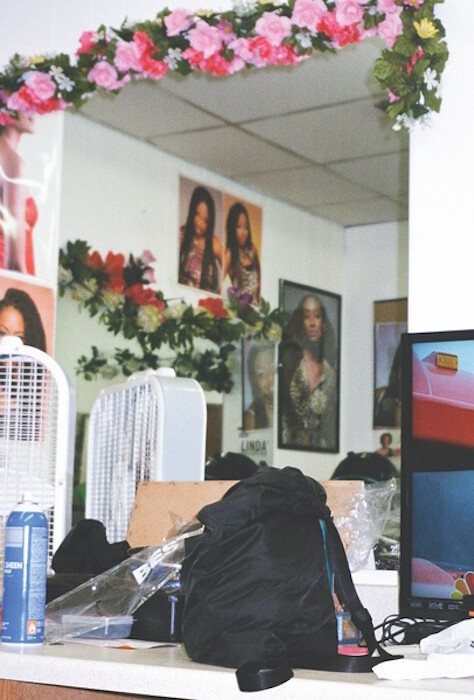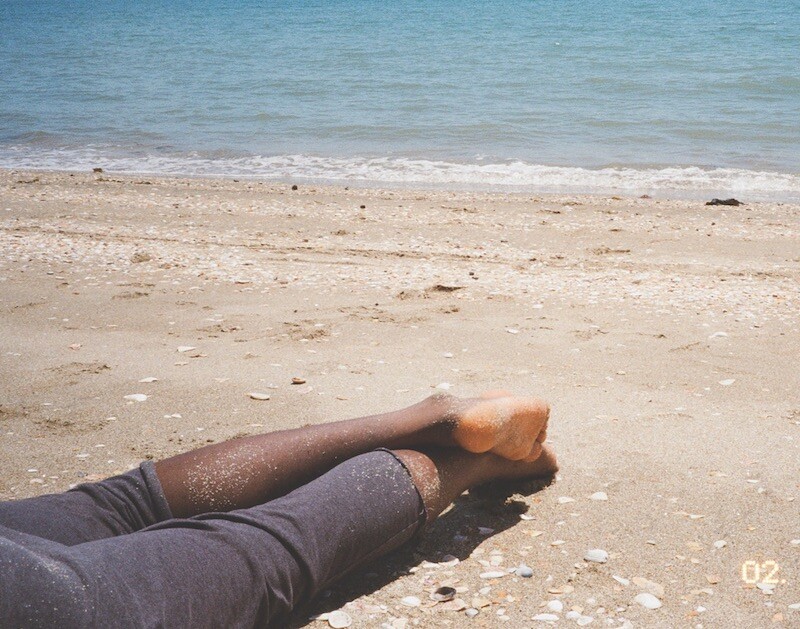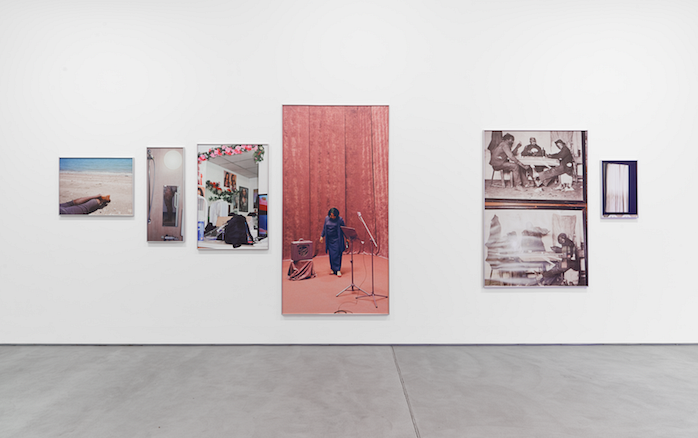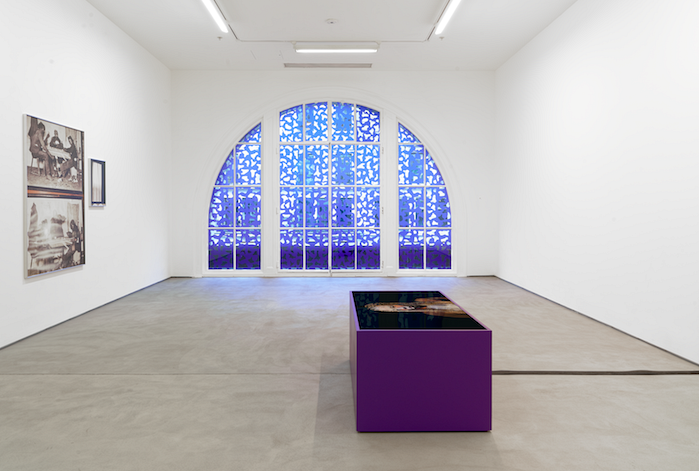What’s to be gained from aestheticizing resistance, from reducing political protest and its violent and repressive fallout to a highly stylized image? This is the final question raised by Martine Syms’s second solo show in London, a tastefully oblique, risk-free display that simultaneously draws on and hollows out the recent history of African American-led demonstrations against police brutality and institutional racism.
Installed in a modest gallery accessible through the main expanse of Sadie Coles HQ, temporary host to New York’s Bridget Donahue during Condo,1 “The Easy Demands” brings together three works: a structural intervention, a single-channel video loop, and a collection of photographic prints. Although superficially unified by being presented in the same space, they remain conceptually and aesthetically disconnected; in fact, the exhibition operates on and fosters an attitude of detachment. It is a dynamic that surfaces in relation to the works on show, in the relationship between the artist and host institution, and in the spectatorial mode produced by the gallery’s oppressive air of exclusivity, which Syms frustratingly does not disrupt.
Belief Strategy XIII (2016) is a dappled color filter applied to the oval window covering one end of the gallery. To create it Syms has appropriated a tool from her previous trade as a producer of broadcast media. The blue filter, irregularly punctuated by dotted negative spaces, is apparently used to produce a lighting effect in film and television. It performs no such function in the gallery. Here, shorn of use value, abstracted from its context and signifying nothing, it stands, by default, as an object presented for disinterested contemplation—an aesthetic burden its form can’t carry.
Hung along another wall are six photographic prints. Varying in size and resolution, they resemble a kind of cryptic visual puzzle. Arbitrary framing, an amateur roughness, and contrasting levels of definition give them the distinct feel of found photography; like photos developed from a long-lost roll, the series’ logic seems random, but oddly familiar. Half Sheet (all photographs 2017) sees bare feet on a beach; Insert, a naked, feet-to-midriff, self-portrait taken in a bathroom mirror; 40X60, perhaps a smart phone photo of an archival print featuring antebellum-era African Americans’ playing cards; Three Sheet, a plush recording studio session, where the singer is black and wears black, and stands out against pink drapery and carpet.
These are not, however, found photographs. They are a series of production stills from a film Syms is currently producing. “I don’t know the title of the film. You’ll have to go on Bridget Donahue’s website,” says the woman behind the long white desk on the gallery’s second floor. We are in conversation about the lack of gallery interpretation. The exhibition handout features no details about the art, its impetus, or any overarching conceptual investigation. Instead Syms reprints what appears to be a letter (that may or may not have been written to a friend) in which she talks of existential crisis. “It’s impossible for me to write these days,” she writes. I ask the gallery assistant for more information. She asks the front desk and I follow. The irritated receptionist replies she has ‘no more information’ and that “a press release [of some 200 pages] is available on Bridget Donahue’s website.” “Is this how Condo works?” I ask, “You host an artist in your gallery and none of the staff have any idea why the work is here or what the work is about?” The receptionist looks to her colleague at the desk’s other end. He stops typing. She turns back to me, “the photographs are stills from a video Syms is making and they are printed in the standard sizes used to promote films.” The six images are advertisements for something yet to be released. What is left following the discovery of that flatly self-referential end, after a disclosure that offers no opportunity for emotional or theoretical attachment to supplement the aesthetic lack? What remains is detachment.
In contrast, Lesson LXXV (2017) is a slick, dramatically composed, high-definition video loop of such short duration it is more like a GIF. A black woman stands forlorn; milk covers her face and drips perpetually from her chin. This is a reference to African American-led demonstrations in Ferguson (following the shooting of Michael Brown by police officer Darren Wilson in August 2014) and elsewhere in the US, where protestors poured milk over their faces to soothe the painful effects of tear gas.
But what does an image like this do with Ferguson’s legacy, particularly within the specific gallery context of Sadie Coles HQ? In the first instance (and by its formal nature) it reduces, simulates, and neatly reframes an act of resistance in the decisive moment’s scopic and spectacular terms. This is not to condemn images of political protest outright. But, in much the same way that pictures of protest circulated online are incapable of articulating (unless accompanied by expository text) essential aspects of the complex web of (in this instance) institutional racism, police brutality, and the ineffectual black elitist politics of Barack Obama, Lesson LXXV, as just an image, can offer nothing more than a highly aestheticized experience of affect. But to what ends? As the work exists in a for-sale edition of five, one end is the accumulation of capital. The other could be spectator activation; the idea that gallery visitors may see Lesson LXXV as the key to unlocking and recognizing “The Easy Demands” as an exercise in aesthetic liberation, an intervention disrupting normative representational expectations—i.e. that contemporary art is primarily a medium for white bodies and white Western concerns. The exhibition’s willful opacity in flirting with such charged material makes it difficult to see how.
Perhaps too much is being expected here. After all, “The Easy Demands” isn’t a career defining, major solo show in a large-scale public gallery. It is, rather, a small exhibition in a top-tier commercial space. Sadie Coles HQ may not be the venue for a fully realized and clearly explicated political vision. Still, doesn’t its very lack of suitability for such a project, the inappropriateness of biting the manicured hand that feeds you and puncturing the gallery’s carefully maintained air of seamless, austere refinement, make the prospect of such an endeavor all the more necessary and pertinent?
Therein lies the final lack in “The Easy Demands,” the artist’s disregard for the institution in which her work is shown. Sadie Coles HQ is not just another neutral space: it is a highly profitable venture2 in which capital is accumulated in exchange for the intangible effects and affects offered by productions of contemporary art. That is not to say all artists must include some kind of institutional critique when showing in any commercial space. However, in this particular instance Sadie Coles’ nature is especially relevant, noteworthy, and at issue because the hierarchical organization thrives on a system diametrically opposed to the horizontal intentions and operations of #BlackLivesMatter, protest in general, and progressive African American movement.
To return to the letter reprinted in the gallery handout, it may be the case that “The Easy Demands” is the product of an artist unsure of where art fits in relation to socio-political developments that have taken place over the last six years. “What are my easy demands?” she writes. But why is this existential crisis contained in the neat grammar and syntax of the printed word? Why doesn’t it break out into the gallery? Why can’t we see it on the walls? The formal suppression of that crisis means it is displaced and transferred elsewhere, to the sensitive spectator, to the vigilant critic. What does it mean for me as a black writer to criticize the work of a black artist when so few are allowed to have any kind of presence in the art world? Am I just providing meaningless content that will maintain the e-flux brand? What is the point of art criticism when racism is on the rise? The banal self-reflection of a reluctant art critic would have undoubtedly been more cogent and vital, if that process was carried out by an incisive and important contemporary artist, assessing her own position within the order of things. This is what makes “The Easy Demands” such a frustrating experience. There are many inconsequential artists, who produce institutionally acceptable, uninspired, and derivative work. Martine Syms is not one of them. But the promise of a politicized, crucial, and much needed practice has not been fulfilled here. “The Easy Demands” is a missed opportunity.
Condo is a collaborative exhibition staged by 36 commercial galleries whose represented artists are shown across 15 commercial spaces in London. 2017 is the initiative’s second year.
Sadie Coles HQ’s 2015 financial report is publicly available, and can be accessed here: http://www.192.com/atoz/financial/business/03211376/
